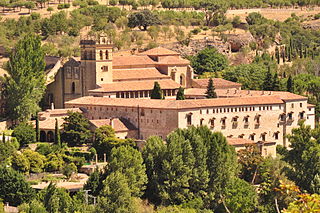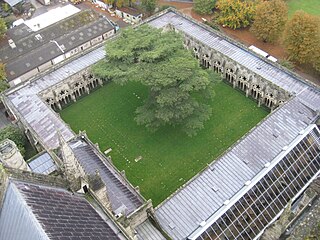
An abbey is a complex of buildings used by members of a religious order under the governance of an abbot or abbess. It provides a place for religious activities, work, and housing of Christian monks and nuns.

The Poor Clares, officially the Order of Saint Clare – originally referred to as the Order of Poor Ladies, and later the Clarisses, the Minoresses, the Franciscan Clarist Order, and the Second Order of Saint Francis – are members of a contemplative Order of nuns in the Catholic Church. The Poor Clares were the second Franciscan Order to be established. Founded by Saints Clare of Assisi and Francis of Assisi on Palm Sunday in the year 1212, they were organized after the Order of Friars Minor, and before the Third Order of Saint Francis. As of 2011 there were over 20,000 Poor Clare nuns in over 75 countries throughout the world. They follow several different observances and are organized into federations.

A storm shelter or storm cellar is a type of underground bunker designed to protect the occupants from violent severe weather, particularly tornadoes. They are most frequently seen in the Midwest and Southeast United States where tornadoes are generally frequent and the low water table permits underground structures.

The Church of San Zaccaria is a 15th-century former monastic church in central Venice, Italy. It is a large edifice, located in the Campo San Zaccaria, just off the waterfront to the southeast of Piazza San Marco and St Mark's Basilica. It is dedicated to St. Zechariah, the father of John the Baptist.

Waverley Abbey was the first Cistercian abbey in England. It was founded in 1128 by William Giffard, Bishop of Winchester. Located in Farnham, Surrey, about 2 miles (3.2 km) southeast of the town centre, the abbey is situated on a floodplain, surrounded by current and previous channels of the River Wey. It was damaged on more than one occasion by severe flooding, resulting in rebuilding in the 13th century. Despite being the first Cistercian abbey in England, and being motherhouse to several other abbeys, Waverley was "slenderly endowed" and its monks are recorded as having endured poverty and famine.

A salt cellar is an article of tableware for holding and dispensing salt. Salt cellars can be either lidded or open, and are found in a wide range of sizes, from large shared vessels to small individual dishes. Styles range from simple to ornate or whimsical, using materials including glass and ceramic, metals, ivory and wood, and plastic.

Alaverdi Monastery is a Georgian Eastern Orthodox monastery located 25 km (16 mi) from Akhmeta, in the Kakheti region of Eastern Georgia. While parts of the monastery date back to 6th century, the present day cathedral was built in the 11th century by Kvirike III of Kakheti, replacing an older church of St. George.
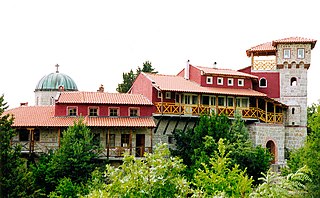
Tvrdoš Monastery is a 15th-century Serbian Orthodox monastery near the city of Trebinje, Republika Srpska, Bosnia and Herzegovina. The 4th-century foundations of the first Roman church on the site are still visible.
Phonaesthetics is the study of beauty and pleasantness associated with the sounds of certain words or parts of words. The term was first used, perhaps by J. R. R. Tolkien in this sense, during the mid-twentieth century, deriving from the Greek: φωνή phōnē, "voice-sound" plus Greek: αἰσθητική aisthētikē, "aesthetic". Speech sounds have many aesthetic qualities, some of which are subjectively regarded as euphonious (pleasing) or cacophonous (displeasing).

Conches-sur-Gondoire is a commune on the Gondoire river in Brie, in the Seine-et-Marne department in the Île-de-France region in north-central France. It is roughly 13 miles (21 km) from Paris.

Eberbach Abbey is a former Cistercian monastery near Eltville am Rhein in the Rheingau, Germany. On account of its Romanesque and early Gothic buildings it is considered one of the most significant architectural heritage sites in Hesse.
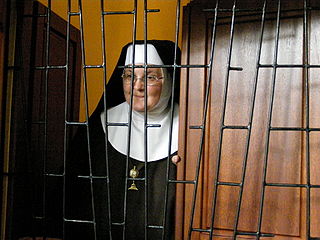
Enclosed religious orders of the Christian churches have solemn vows with a strict separation from the affairs of the external world. The term cloistered is synonymous with enclosed. In the Catholic Church enclosure is regulated by the code of canon law, either the Latin code or the Oriental code, and also by subsidiary legislation. It is practised with a variety of customs according to the nature and charism of the community in question.

Kingswood Abbey was a Cistercian abbey, located in the village of Kingswood near Wotton-under-Edge, Gloucestershire, England. The abbey was demolished during the Dissolution of the Monasteries, and all that remains is the gatehouse, a Grade 1 listed building. Through the gatehouse arch are a few houses and the small village primary school of Kingswood.

Kőröshegy is a village directly south of Balatonföldvár in Siófok District, Somogy County, Hungary.

Asserbo Charterhouse is a fortress and Carthusian monastery ruin in the small town of Asserbo north of Frederiksværk on North Zealand in Denmark.
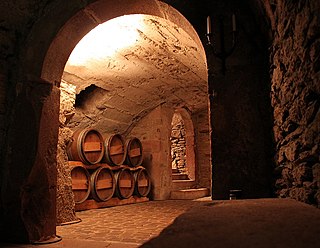
A buttery was originally a large cellar room under a monastery, in which food and drink were stored for the provisioning of strangers and passing guests. Nathan Bailey's An Universal Etymological English Dictionary gives "CELLARIST – one who keeps a Cella, or Buttery; the Butler in a religious House or Monastery." As the definition in John Stevens's The History of the Antient Abbeys shows, its initial function was to feed and water the guests rather than monks: "The Buttery; the Lodging for Guests". In a monastery a buttery was thus the place from which travellers would seek 'doles' of bread and weak ale, given at the exterior buttery door. The task of doling out this free food and drink would be the role of the butterer. At larger monasteries there would also be a basic hostelry, where travellers could sleep for free.
Whitefriars is an area in the Ward of Farringdon Without in the City of London. Until 1540, it was the site of a Carmelite monastery, from which it gets its name.

St Augustine's Abbey was a Benedictine monastery in Canterbury, Kent, England. The abbey was founded in 598 and functioned as a monastery until its dissolution in 1538 during the English Reformation. After the abbey's dissolution, it underwent dismantlement until 1848. Since 1848, part of the site has been used for educational purposes and the abbey ruins have been preserved for their historical value.


